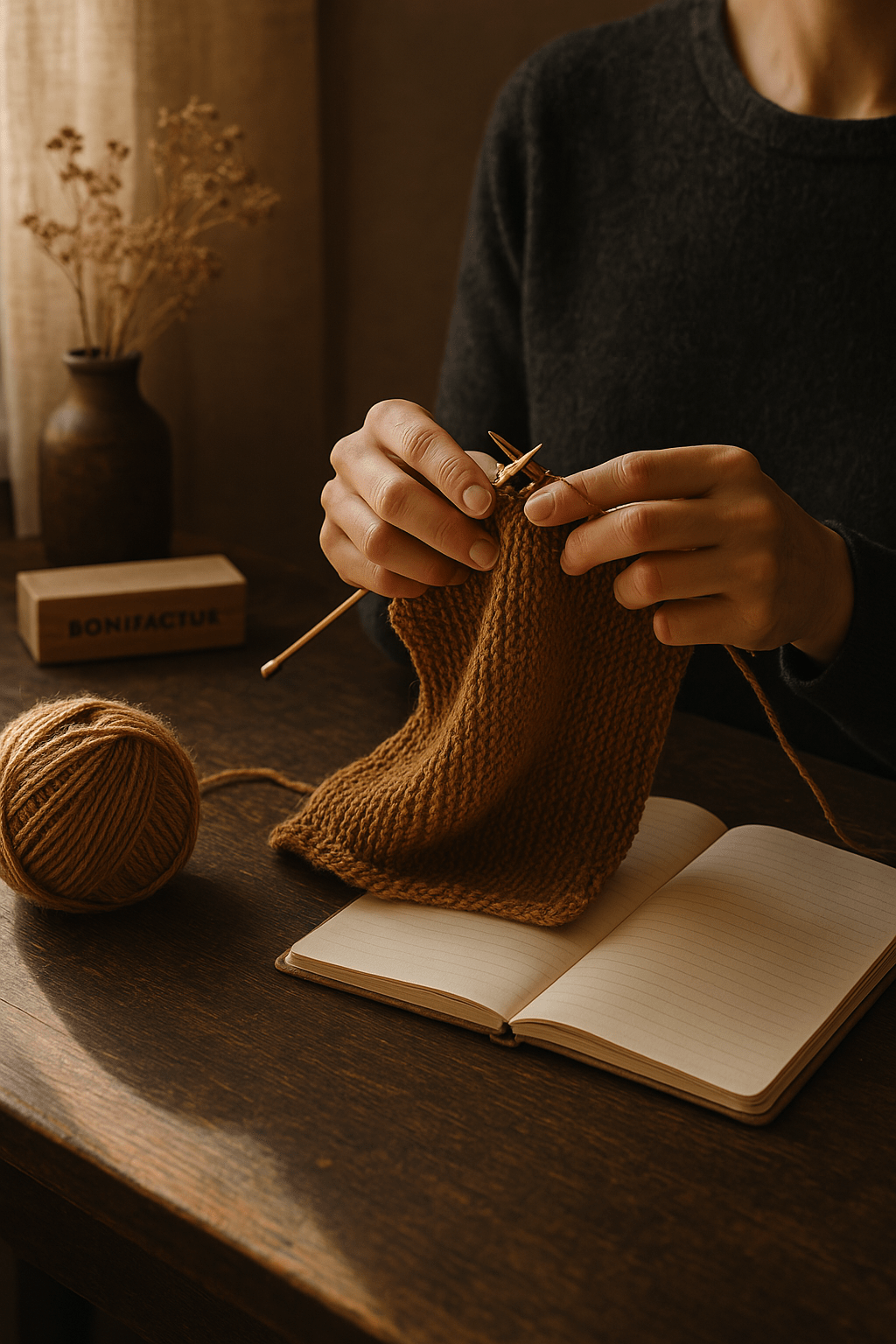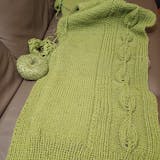Not faster. More beautiful.
There's that moment in knitting when your hands have found their own rhythm. When you no longer have to think about every stitch, but your fingers know what to do as if by themselves. You've reached that point—where technique becomes second nature and creativity can flourish.
At Bonifaktur, we believe that true mastery lies not in the complex, but in the deepening of the simple. This article is for those who have internalized the basic rhythm of knitting and are now ready to refine their craft—not to impress, but to serve the beauty that resides within.
1. The art of conscious material
As an advanced knitter, you've long known that different yarns have different properties. But the real art lies in consciously using these properties for your project.
Merino wool breathes differently than alpaca, silk reflects light differently than cotton. Each fiber carries its own story, its own sensuality. The master doesn't just choose what works or looks beautiful—she chooses what underlines the soul of a project.
Our tip: Work with yarn combinations that seem unconventional at first glance. A strand of ultra-thin mohair with a strand of silk not only creates unexpected texture, but also a depth that wouldn't be possible with a single yarn. Experiment with the contrast between matte and shiny, between volume and flow.
2. The Wisdom of Tension
Tension is the invisible architecture of every knitted piece. As an advanced knitter, you're aware of this—but how many of us regularly check not only our gauge, but also our emotional tension while knitting?
The mood in which we knit is subtly transferred to our work. A piece crafted in a hurry embodies this haste. One created in peace radiates this serenity. The master knows that tension lies not only in the hands, but in the entire being.
Our tip: Consider your gauge not only technically, but also emotionally. How do you feel while knitting? What quality do you want to weave into your piece? Sometimes it's better to put the knitting aside when the internal tension is too high—or to knit consciously at that very moment to transform that tension.
3. The poetry of negative space
In Japanese aesthetics, there's the concept of "ma"—the meaningful space between things. As a master knitter, you can apply this principle to your work. Not every piece of knitting needs to be dense and complete. Sometimes it's precisely the deliberately left space that gives a piece its special impact.
Experiment with openwork patterns not just as a technical exercise, but as a conscious choice for lightness. Allow air and light to flow through your work. True mastery is revealed not always in what we add, but also in what we omit.
Our tip: Study traditional lace patterns from different cultures and observe how they play with the relationship between fullness and emptiness. Apply these principles to modern designs. A simple garment with strategically placed openwork elements can have a more powerful effect than a consistently complex pattern.
4. Understanding the depth of colors
Color is more than aesthetics—it's psychology, cultural history, and personal memory. As an advanced knitter, you can begin to work with color on a deeper level. Not just what appeals, but what moves you.
The master understands that certain shades emerge while others recede. That some colors activate, others calm. She knows the subtle differences between a gray with a bluish undertone and one with warm beige. And she uses this knowledge not for effect, but for expression.
Our tip: Create a personal color collection—not just from yarn swatches, but from all the materials that appeal to you. Fabrics, papers, natural materials. Observe which color combinations you're drawn to again and again. Deepen your understanding not only of colors themselves, but also of their relationships to one another. Sometimes it's precisely the subtle transitional shade that gives a color composition its soul.
5. The heritage of craftsmanship
In an age of unlimited online tutorials and instant information, there is particular value in studying traditional knitting techniques from different cultures—not as a folkloric exercise, but as a connection to a long line of craftspeople who came before us.
Estonian lace, the Persian variety of patterns, the Nordic stars – behind every traditional pattern lies not just a technique, but a worldview. The master understands that she is part of a continuum and honors this heritage by keeping it alive and carefully developing it further.
Our tip: Choose a traditional knitting technique that particularly appeals to you and study it in depth. Not just the patterns themselves, but also their cultural context. What were the living conditions of the people who developed this technique? What materials were available to them? What symbolic meaning did certain patterns hold? This understanding will enrich your own work with a depth that goes beyond mere aesthetics.
6. The elegance of the construction
Advanced knitters understand that a truly successful piece must be thought through from the inside out. The construction—how stitches are increased and decreased, how pieces are joined, how the piece ultimately fits on the body—is not just a technical detail, but crucial to the integrity of the entire work.
The master knows that an invisible transition, a perfectly placed decrease row, a well-considered neckline contributes just as much to beauty as the most striking pattern. She understands that true elegance often lies in the details no one sees.
Our tip: Study the construction principles of garments, not just in the knitting world. How are well-fitting tailoring constructed? Which architectural principles can be applied to knitting? Experiment with unconventional constructions – from the center out, from top to bottom, diagonally. Sometimes an unusual construction method can lead to a piece that appears particularly natural.
7. The Wisdom of the Hand
In an increasingly digitalized world, the conscious decision to work by hand is a revolutionary act. As an advanced knitter, you're aware of the meditative quality of knitting, but you can deepen this awareness even further.
The master sees knitting not only as a way of creating something, but as a practice of presence. Each stitch becomes an opportunity to be fully in the moment. The finished piece bears the traces not only of her technical skill, but also of her concentrated attention.
Our tip: Experiment with conscious, slow knitting. Choose a special project and devote your full attention to it—no podcasts, no TV, no distractions. Feel every movement, the glide of the yarn between your fingers, the rhythm of the needles. This deep connection to the process itself will infuse your work with a quality that cannot be measured in technical terms.
8. The freedom of improvisation
One of the greatest joys for the advanced knitter is the moment when she can break away from instructions and follow her own creative impulses. No longer "playing by the book," but free improvisation – that is mastery.
This doesn't mean that every piece has to be completely reinvented. As in music, improvisation in knitting can be built on solid foundations. The master understands the rules so well that she knows when and how to break them—not out of carelessness, but out of creative necessity.
Our tip: Start with small improvisations. Take a familiar pattern and deliberately change one element—a different collar, a modified arm construction, an added pattern. With each conscious change to an existing structure, your confidence in your own creative voice grows. Over time, you may find that you no longer need complete patterns—just inspiration that you translate into your own knitting language.
9. The attitude of the eternal student
Paradoxically, one of the signs of true mastery is the recognition of how much there is still to learn. The master knows that mastery is not a destination, but a path. She maintains the curiosity and openness of a beginner, even though her hands have long since shown the confidence of years of practice.
This attitude protects against stagnation and continually opens new horizons. It allows us to learn from both the eighty-year-old knitting master and the young designer who brings fresh perspectives.
Our tip: Regularly challenge yourself with a new challenge—a technique you haven't yet mastered, a material you haven't worked with before, a style that doesn't match your usual aesthetic. These deliberate steps out of your comfort zone not only keep your technical skills alive, but also your creative curiosity. The willingness to repeatedly be a beginner is perhaps the greatest gift you can give yourself as an experienced knitter.
At Bonifaktur, we believe that true beauty emerges when hands and heart work together. As an advanced knitter, you've mastered the technical basics—now the path is open to developing and refining your very own knitting voice.
We don't see our role as telling you what to knit, but rather as accompanying you on your creative journey. With materials that celebrate your mastery, with colors that appeal to your senses, and with a space where your art can unfold – at your own pace, by your own standards.
Welcome to Bonifaktur – where every stitch is a choice for beauty.
Yarn with soul. For people with heart.






Color Stories: How colors influence our knitting projects and our mood
Why hand-dyed yarns are more than just color